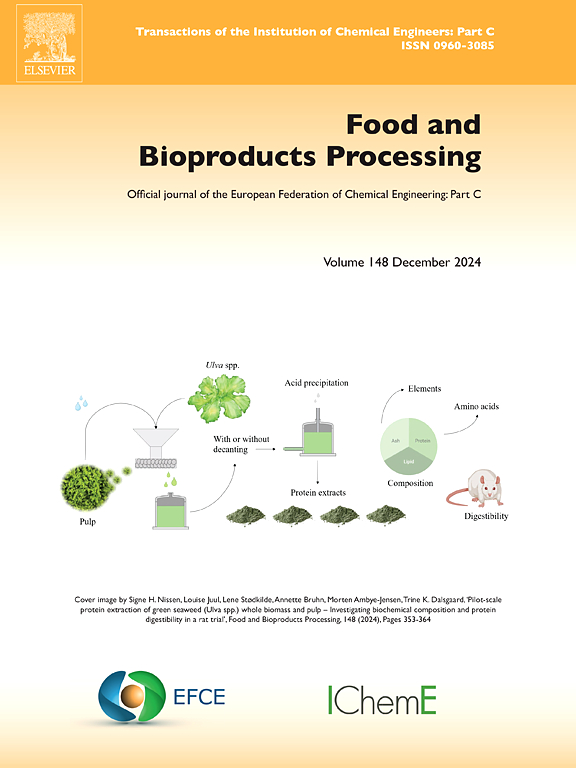Incorporation of low-pH purple-fleshed sweet potato (Ipomoea batatas L.) anthocyanin extract into a sucrose matrix: Characterization and application in powdered beverage
IF 3.5
2区 农林科学
Q2 BIOTECHNOLOGY & APPLIED MICROBIOLOGY
引用次数: 0
Abstract
This study investigates incorporating the remarkable color, bioactive compounds, and physiological properties of purple-fleshed sweet potato anthocyanin (PSPA) into sucrose as a carrier for developing anthocyanin-enriched powdered beverages. The effects of PSPA extract on the physicochemical and sensory characteristics of anthocyanin-enriched powdered beverages were evaluated, focusing on two factors: the pH of the extract (2.18 and 2.39) and the ratio of anthocyanin extract to sucrose (E/S) (7.14 %, 10.7 %, and 14.3 % v/w). The results showed that the anthocyanin entrapment efficiency ranged from 58.4 % to 82.5 %, with increasing E/S ratio or decreasing pH enhancing the redness (a*), chroma (Ch), total anthocyanin content (TAC), and solubility. However, these conditions also led to less favorable characteristics in moisture content, hygroscopicity, bulk density, and tapped density. Meanwhile, higher total phenolic content (TPC) and antiradical power (ARP) were observed with increased E/S and pH levels. FTIR analysis confirmed that PSPA was incorporated into the sucrose matrix without reacting chemically with the sucrose. We classified the formation of anthocyanin-enriched sucrose powder as co-precipitation based on the high nucleation rate, surface morphology, and other characteristics. Morphological analysis revealed that the anthocyanin-enriched sucrose powder comprised agglomerates with irregular, porous, and rough surfaces. DSC thermogram indicated an endothermic peak around 190 °C, suggesting the anthocyanin-enriched sucrose powder still had crystalline regions, as further supported by X-ray diffraction data. Beverages formulated with anthocyanin extract at a pH of 2.18 showed higher color preferences than those at 2.39. Principal component analysis (PCA) and hierarchical cluster analysis (HCA) revealed correlations and clustering of the physicochemical and sensory properties of the anthocyanin-enriched sucrose powder.
低ph紫肉甘薯(Ipomoea batatas L.)花青素提取物掺入蔗糖基质:表征及其在粉状饮料中的应用
本研究探讨了将紫肉甘薯花青素(PSPA)的显着颜色、生物活性化合物和生理特性融入蔗糖中,作为开发富含花青素粉末饮料的载体。以花青素提取物的pH值(2.18和2.39)和花青素提取物与蔗糖的比值(E/S)(7.14 %、10.7 %和14.3 % v/w)为研究对象,考察了花青素提取物对花青素粉末饮料理化特性和感官特性的影响。结果表明,花青素包埋率在58.4 % ~ 82.5 %之间,随着E/S比的增大或pH值的降低,花青素的红度(a*)、色度(Ch)、总花青素含量(TAC)和溶解度均有所提高。然而,这些条件也导致了水分含量、吸湿性、体积密度和抽头密度等不太有利的特性。同时,随着E/S和pH的升高,总酚含量(TPC)和抗自由基能力(ARP)均有所提高。FTIR分析证实PSPA被纳入蔗糖基质中,没有与蔗糖发生化学反应。基于高成核率、表面形貌等特征,我们将富花青素蔗糖粉的形成归类为共沉淀。形态学分析表明,富含花青素的蔗糖粉由不规则、多孔和粗糙表面的团块组成。DSC热图显示在190 °C左右有一个吸热峰,表明富含花青素的蔗糖粉仍有结晶区域,x射线衍射数据进一步支持了这一点。与pH值为2.39的饮料相比,pH值为2.18的花青素提取物饮料表现出更高的颜色偏好。主成分分析(PCA)和层次聚类分析(HCA)揭示了花青素蔗糖粉理化性质和感官性质的相关性和聚类性。
本文章由计算机程序翻译,如有差异,请以英文原文为准。
求助全文
约1分钟内获得全文
求助全文
来源期刊

Food and Bioproducts Processing
工程技术-工程:化工
CiteScore
9.70
自引率
4.30%
发文量
115
审稿时长
24 days
期刊介绍:
Official Journal of the European Federation of Chemical Engineering:
Part C
FBP aims to be the principal international journal for publication of high quality, original papers in the branches of engineering and science dedicated to the safe processing of biological products. It is the only journal to exploit the synergy between biotechnology, bioprocessing and food engineering.
Papers showing how research results can be used in engineering design, and accounts of experimental or theoretical research work bringing new perspectives to established principles, highlighting unsolved problems or indicating directions for future research, are particularly welcome. Contributions that deal with new developments in equipment or processes and that can be given quantitative expression are encouraged. The journal is especially interested in papers that extend the boundaries of food and bioproducts processing.
The journal has a strong emphasis on the interface between engineering and food or bioproducts. Papers that are not likely to be published are those:
• Primarily concerned with food formulation
• That use experimental design techniques to obtain response surfaces but gain little insight from them
• That are empirical and ignore established mechanistic models, e.g., empirical drying curves
• That are primarily concerned about sensory evaluation and colour
• Concern the extraction, encapsulation and/or antioxidant activity of a specific biological material without providing insight that could be applied to a similar but different material,
• Containing only chemical analyses of biological materials.
 求助内容:
求助内容: 应助结果提醒方式:
应助结果提醒方式:


